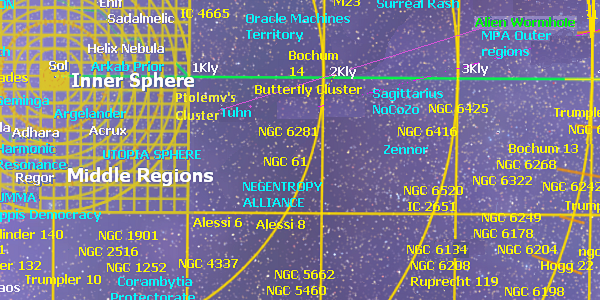BY LETTER
Tunh Xenohole, The
Galactography > Regions of Space > Middle Regions/Hinter-regions
Galactography > Regions of Space > Outer Volumes
Galactography > Other Major Polities, Empires, and Meta-Empires > Sagittarius Transcultural Cooperation
Galactography > Systems and Worlds > Systems & Worlds S - T
Sophonts > Xenosophonts
Galactography > Regions of Space > Outer Volumes
Galactography > Other Major Polities, Empires, and Meta-Empires > Sagittarius Transcultural Cooperation
Galactography > Systems and Worlds > Systems & Worlds S - T
Sophonts > Xenosophonts
 Image from Steve Bowers | |
| The Alien wormhole at Tunh. Like the alien 'hole at OF-Star-4, this 'hole has opened up a large region of space many thousands of lightyears from Sol to colonisation. The Tunh xenohole stretches from MPA territory more than two thousand light years to the heart of what is now the Sagittarius Transcultural Cooperation | |
System Neb 34786
Type T1 Brown Dwarf
Distance from Sol 1237 ly
RA 16.8773
Dec -39.56
Constellation Scorpius
Planet Gatto
Radius 5511km
Wormhole Mouth 601 AU from primary, radius in current era 7.8km
Location of distal wormhole mouth 3309ly from Sol, in Sagittarius
In 3965 the Lagrange Defenders, a research/exploration megacorp-institute discovered an artificial structure in the system Neb 34786, 1237 ly from Sol.
The structure turned out to be a still-functioning wormhole (xenohole) of alien origin. The Lagrange xenoarcheologists found that it was maintained by advanced automation, believed to be non-intelligent at the time. As they explored through the wormhole, they found that it was the remnant of a wormhole network approximately 33 million years old extending through the region between the Orion and Sagittarius arms. The Tunnlers (as the aliens came to be called) appeared to have once had a much more extensive network, but over time links had failed, disconnecting the discovered links from the rest.
Another similar wormhole, later discovered in Carina at OF-Star-4, was once part of the same network. Both wormholes have suffered galactic drift since their creation, and were once close together; they are now many thousands of light years apart.
The discovery electrified many expansionist groups, as it suggested that there were more wormhole fragments up for grabs. It also interested several exploration institutes and megacorps as a way of reaching the Sagittarius arm; this was the reason the Sagittarius Project was instituted, with Lagrange as one of the main sponsors
Neb 34786 became known as Tunh, and emerged as a focal point for expansionism, research and politics. For the first decades there was a very real risk of invasion as several nearby empires shook their weapons, but thanks to the skilful diplomacy of Lagrange Defenders and their Hod allies Tunh became an independent neutral polity, the Tunh Logika (of course still largely a puppet government to Lagrange). Tunh Logika began to terraform Gatto, a world with extensive Tunnler ruins on its moons
In 4094 it was discovered that the Tunnler wormhole in fact housed a powerful xenotech AI, which was still active, though largely dormant. This caused a major crisis, as Lagrange and Tunh Logika swiftly stopped all traffic in order not to risk anything, despite massive pressure and some threats from expansionist groups having high stakes in the colonisation of the Sagittarius region. Communications between the wormhole AI and xenolinguistic human AIs revealed that the wormhole AI had a complex belief system based on the concept of duty, perhaps as a kind of control system imposed by its creators or the result of millions of years of isolation. The AI was not particularly interested in any cultural, technological or other exchange, but was content to let humans use the wormholes as long as the AI was left alone to experience its perfect duty.
Since then very little communication has occurred and additional Tunnler finds have been few. There is a widespread suspicion that the AI regard its former creators as having abandoned their duties. Some people worry that the AI might actually have helped its masters to go extinct, and warn against trusting the wormhole mind.
In 4100 Tunh Logika formally joined the Institute of Exopaleontology as a department-nation. Over the last millennium the Tunh system had become not just a major trade nexus but also the local center for xenobiology and long-range research. The move to become a part of the Institute was largely political at the time, a way of ensuring that the neighbouring and at the time both militant and successful Kringsler Volume would be discouraged from attacking the system by outside pressure. The move was successful, and while the Kringsler empire soon imploded due to an economic schism Tunh Logika remained a very profitable part of the Institute, acting as the local headquarters
During the Version War the Tunh system was attacked by a small Cygexpa force, and while the Tunh wormhole was not damaged several major habitats on the surface of Gatto were destroyed. Tunh Logika survived just barely, and when the Sagittarius Transcultural Cooperation was created this system was a founding member. The xenohole was connected to the Terragen wormhole Nexus some time after the war was finished, in 5500 AT.
 Image from Steve Bowers | |
| The Tunh wormhole extends for more than 2000 ly, from Scorpius to Sagittarius, and has allowed rapid expansion into the Sagittarius Arm | |
Related Articles
- Kringsler Volume - Text by M. Alan Kazlev
A region near Tunh that was formerly dominated by Kringslerism. - Kringslerism - Text by Anders Sandberg
Business-religion combining ancient Christianity with market worship and some unhealthy elements of fascism. It lasted from 3850-4100, and eventually collapsed into schism. The Kringslerites then began a drawn out genocidal war among themselves until everybody lost sight of them during the Version War. - Oh-F-Star-4 - Text by M. Alan Kazlev
The capital of the Carina rush. Contains a wormhole of alien origin spanning three thousand light years and connecting to a system in the direction of the Carina Nebula. - Terragen Expansion
- Wormhole Nexus, The
- Wormholes - A Layman's Guide
- Wormholes - Cultural Factors
Appears in Topics
| Middle Regions/Hinter-regions | Outer Volumes | Sagittarius Transcultural Cooperation |
| Systems & Worlds S - T | Xenosophonts |
Development Notes
Text by Anders Sandberg, with comments by Steve Bowers.
Initially published on 01 July 2000.
updated by steve bowers august 2020
Initially published on 01 July 2000.
updated by steve bowers august 2020






